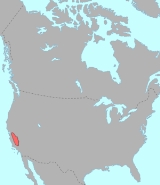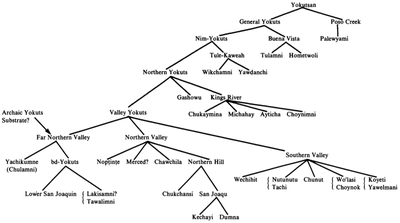
Yokutsan languages
Encyclopedia
Yokutsan is an endangered
language family
spoken in the interior of Northern and Central California
in and around the San Joaquin Valley
by the Yokut people. The speakers of Yokutsan languages were severely affected by disease, missionaries
, and the Gold Rush
. While descendants of Yokutsan-family speakers currently number in the thousands, most of the constituent languages are now extinct
.
The Yawelmani dialect of Valley Yokuts has been a focus of much linguistic
research.
 The Yokutsan family consists of half a dozen languages, depending upon one's definition of the boundary between a language and a dialect. An estimated forty linguistically distinct groups existed before Euro-American contact. The following classification appears in Whistler & Golla (1986).
The Yokutsan family consists of half a dozen languages, depending upon one's definition of the boundary between a language and a dialect. An estimated forty linguistically distinct groups existed before Euro-American contact. The following classification appears in Whistler & Golla (1986).
Poso Creek
General Yokuts (all others)
Many Yokutsan varieties
are extinct, as noted above. Those that are still spoken are endangered. In recent years, Choinimni, Wikchamni, Chukchansi, Kechayi, Tachi, and Yawelmani all had a few fluent speakers and a variable number of partial speakers. Wikchamni, Chukchansi, Tachi, and Yawelmani were being taught to at least a few children during the first decade of the twenty-first century. Chukchansi is now a written language, with its own alphabet developed on a federal grant. Chukchansi also has a phrase book and dictionary that are partially completed.
The term "Delta Yokuts" has recently been introduced in lieu of the longer "Far Northern Valley Yokuts" for the language spoken by the people in the present Stockton and Modesto vicinities of San Joaquin and Stanislaus counties, California, prior to their removal to Mission San Jose between 1810 and 1827. Of interest, Delta Yokuts contains a large number of words with no cognates in any of the other Yokuts languages, or, for that matter, in the adjacent Utian languages, although its syntax is typically Northern Valley Yokuts (Kroeber 1959:15-17). This anomaly has led Whistler (cited by Golla 2007:76) to suggest, "The vocabulary distinctive of some of the Delta Yokuts dialects may reflect substratal influence from pre-proto-Yokuts or from an extinct Yok-Utian language." Golla (2007:77) suggests that a "pre-proto-Yokuts" homeland was in the Great Basin, citing a rich plant and animal vocabulary for a dry environment and a close connection between Yokuts basketry styles and those of prehistoric central Nevada.
Endangered language
An endangered language is a language that is at risk of falling out of use. If it loses all its native speakers, it becomes a dead language. If eventually no one speaks the language at all it becomes an "extinct language"....
language family
Language family
A language family is a group of languages related through descent from a common ancestor, called the proto-language of that family. The term 'family' comes from the tree model of language origination in historical linguistics, which makes use of a metaphor comparing languages to people in a...
spoken in the interior of Northern and Central California
California
California is a state located on the West Coast of the United States. It is by far the most populous U.S. state, and the third-largest by land area...
in and around the San Joaquin Valley
San Joaquin Valley
The San Joaquin Valley is the area of the Central Valley of California that lies south of the Sacramento – San Joaquin River Delta in Stockton...
by the Yokut people. The speakers of Yokutsan languages were severely affected by disease, missionaries
Missionary
A missionary is a member of a religious group sent into an area to do evangelism or ministries of service, such as education, literacy, social justice, health care and economic development. The word "mission" originates from 1598 when the Jesuits sent members abroad, derived from the Latin...
, and the Gold Rush
Gold rush
A gold rush is a period of feverish migration of workers to an area that has had a dramatic discovery of gold. Major gold rushes took place in the 19th century in Australia, Brazil, Canada, South Africa, and the United States, while smaller gold rushes took place elsewhere.In the 19th and early...
. While descendants of Yokutsan-family speakers currently number in the thousands, most of the constituent languages are now extinct
Extinct language
An extinct language is a language that no longer has any speakers., or that is no longer in current use. Extinct languages are sometimes contrasted with dead languages, which are still known and used in special contexts in written form, but not as ordinary spoken languages for everyday communication...
.
The Yawelmani dialect of Valley Yokuts has been a focus of much linguistic
Linguistics
Linguistics is the scientific study of human language. Linguistics can be broadly broken into three categories or subfields of study: language form, language meaning, and language in context....
research.
Family division

Poso Creek
- Palewyami Yokuts ( Poso Creek, Altinin) (†)
General Yokuts (all others)
- Buena Vista
-
- Tulamni
- Hometwali
- Nim
- Tule–Kaweah
- Wikchamni
- Yawdanchi ( Nutaa)
- Bokninuwad
- Northern Yokuts
- Gashowu
- Kings River
- Chukaymina
- Michahay
- Ayitcha ( Aiticha, Kocheyali)
- Choynimni ( Choinimni)
- Valley Yokuts (see)
Many Yokutsan varieties
Variety (linguistics)
In sociolinguistics a variety, also called a lect, is a specific form of a language or language cluster. This may include languages, dialects, accents, registers, styles or other sociolinguistic variation, as well as the standard variety itself...
are extinct, as noted above. Those that are still spoken are endangered. In recent years, Choinimni, Wikchamni, Chukchansi, Kechayi, Tachi, and Yawelmani all had a few fluent speakers and a variable number of partial speakers. Wikchamni, Chukchansi, Tachi, and Yawelmani were being taught to at least a few children during the first decade of the twenty-first century. Chukchansi is now a written language, with its own alphabet developed on a federal grant. Chukchansi also has a phrase book and dictionary that are partially completed.
Genetic relations
The Yokutsan family is key member family in the proposed Penutian stock. Some linguists consider most relationships within Penutian to be undemonstrated (cf. Campbell 1997). Others consider a genetic relationship between Yokutsan, Utian, Maiduan, Wintuan, and a number of Oregon languages within Penutian to be definite (cf. Delancy and Golla 1997). Regardless of higher-order disagreement, Callaghan (1997) provides strong evidence uniting Yokutsan and Utian as sub-families within a single Yok-Utian language family.The term "Delta Yokuts" has recently been introduced in lieu of the longer "Far Northern Valley Yokuts" for the language spoken by the people in the present Stockton and Modesto vicinities of San Joaquin and Stanislaus counties, California, prior to their removal to Mission San Jose between 1810 and 1827. Of interest, Delta Yokuts contains a large number of words with no cognates in any of the other Yokuts languages, or, for that matter, in the adjacent Utian languages, although its syntax is typically Northern Valley Yokuts (Kroeber 1959:15-17). This anomaly has led Whistler (cited by Golla 2007:76) to suggest, "The vocabulary distinctive of some of the Delta Yokuts dialects may reflect substratal influence from pre-proto-Yokuts or from an extinct Yok-Utian language." Golla (2007:77) suggests that a "pre-proto-Yokuts" homeland was in the Great Basin, citing a rich plant and animal vocabulary for a dry environment and a close connection between Yokuts basketry styles and those of prehistoric central Nevada.
External links
- Yokuts
- Yokuts languages
- Yokuts (Northern Foothill): Lord's prayer
- Chawchila metathesis
- The Yokuts Language of South Central California
- Ethnologue: Yokuts
- Native Tribes, Groups, Language Families and Dialects of California in 1770 (map after Kroeber)
- Yokuts languages language overview at the Survey of California and Other Indian LanguagesSurvey of California and Other Indian LanguagesThe Survey of California and Other Indian Languages at the University of California at Berkeley documents, catalogs, and archives the indigenous languages of the Americas...

